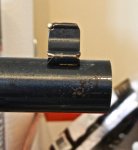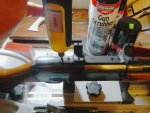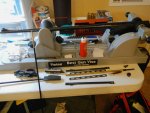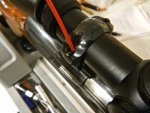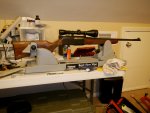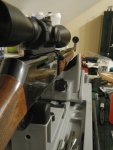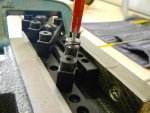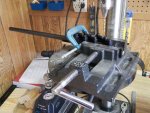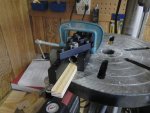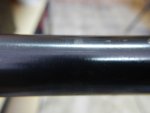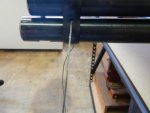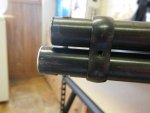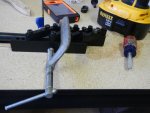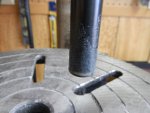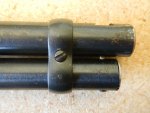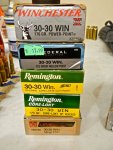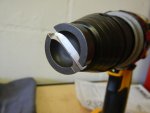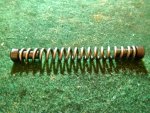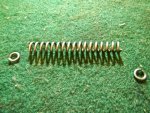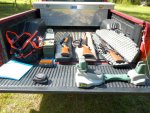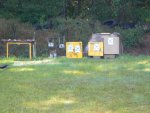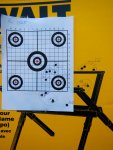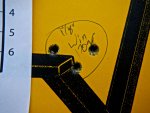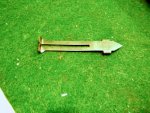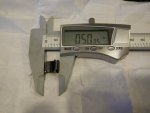hayseed_theology
Senior Member
Update #2 7/13/14
I had more time to work on the gun this past weekend than I have had in the past 2 months combined.
I worked on cutting the dovetail for the front sight. I figured a dovetail was easier for a beginner than drilling and tapping a couple blind holes.
I have a Wheeler Engineering scope leveling kit. It includes two levels. One is a small magnetized piece that sits on the top of the frame(or other flat surface). The other clamps to the barrel and then is adjusted to match the first level. The clamped one stays put allowing for a scope to be mounted or, in my case, the magnetized level to be put on the dovetail cutting jig. All that said, you want the jig to be aligned and properly centered, and the best way to do that is by leveling the gun and leveling the jig.
I started by cutting with the hacksaw to remove as much metal as I could that way. Then, I used my little safe sided triangular file to do the rest. That was a mistake. I should have used the edge of a larger file to remove some more material. It took me forever with that little file! My thumbs are still sore today. I made a mistake using a new hacksaw blade and new file for roughing in the cut. They are completely dull after making a little contact with that hardened jig.
The jig works fine. The dovetail cut in the jig is a little rough as you can see in the 4th pic. I wish it was a little cleaner. The jig is supposed to be undersized, but I feel it's a little too undersized. A standard dovetail is supposed to be .375". The jig is supposed to cut .360"-.370". It's good to have the cut a little undersized. Then, you just take a little off the sight, and you have a great fit. But, my cut is .330" which means I have a long ways to go before I get close to even getting the sight started. The cut is a bit shallow too. I think some careful work with a new file will have it in good shape.
I think it will turn out fine though. I haven't screwed anything up. It just needs a little more work.
Tools: vise, wheeler engineering scope leveling kit, safe sided smooth triangular file, dovetail cutting jig, chalk, wire brush, hacksaw
Cost: $46 for jig and file
I had more time to work on the gun this past weekend than I have had in the past 2 months combined.
I worked on cutting the dovetail for the front sight. I figured a dovetail was easier for a beginner than drilling and tapping a couple blind holes.
I have a Wheeler Engineering scope leveling kit. It includes two levels. One is a small magnetized piece that sits on the top of the frame(or other flat surface). The other clamps to the barrel and then is adjusted to match the first level. The clamped one stays put allowing for a scope to be mounted or, in my case, the magnetized level to be put on the dovetail cutting jig. All that said, you want the jig to be aligned and properly centered, and the best way to do that is by leveling the gun and leveling the jig.
I started by cutting with the hacksaw to remove as much metal as I could that way. Then, I used my little safe sided triangular file to do the rest. That was a mistake. I should have used the edge of a larger file to remove some more material. It took me forever with that little file! My thumbs are still sore today. I made a mistake using a new hacksaw blade and new file for roughing in the cut. They are completely dull after making a little contact with that hardened jig.
The jig works fine. The dovetail cut in the jig is a little rough as you can see in the 4th pic. I wish it was a little cleaner. The jig is supposed to be undersized, but I feel it's a little too undersized. A standard dovetail is supposed to be .375". The jig is supposed to cut .360"-.370". It's good to have the cut a little undersized. Then, you just take a little off the sight, and you have a great fit. But, my cut is .330" which means I have a long ways to go before I get close to even getting the sight started. The cut is a bit shallow too. I think some careful work with a new file will have it in good shape.
I think it will turn out fine though. I haven't screwed anything up. It just needs a little more work.
Tools: vise, wheeler engineering scope leveling kit, safe sided smooth triangular file, dovetail cutting jig, chalk, wire brush, hacksaw
Cost: $46 for jig and file
Attachments
-
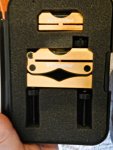 REV205.70.jpg107.3 KB · Views: 1,015
REV205.70.jpg107.3 KB · Views: 1,015 -
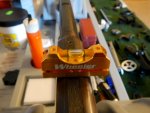 REV205.71.jpg83.9 KB · Views: 1,013
REV205.71.jpg83.9 KB · Views: 1,013 -
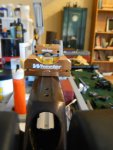 REV205.72.jpg81.4 KB · Views: 1,003
REV205.72.jpg81.4 KB · Views: 1,003 -
 REV205.73.jpg67.7 KB · Views: 1,010
REV205.73.jpg67.7 KB · Views: 1,010 -
 REV205.74.jpg60.7 KB · Views: 1,007
REV205.74.jpg60.7 KB · Views: 1,007 -
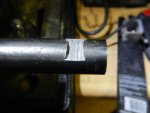 REV205.78.jpg71.3 KB · Views: 1,008
REV205.78.jpg71.3 KB · Views: 1,008 -
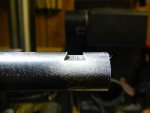 REV205.77.jpg74 KB · Views: 1,016
REV205.77.jpg74 KB · Views: 1,016 -
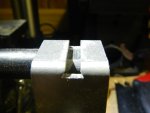 REV205.76.jpg65.9 KB · Views: 1,006
REV205.76.jpg65.9 KB · Views: 1,006 -
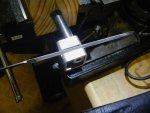 REV205.75.jpg95.6 KB · Views: 1,034
REV205.75.jpg95.6 KB · Views: 1,034
Last edited:


